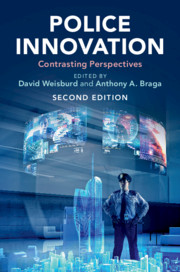Book contents
- Police Innovation
- Police Innovation
- Copyright page
- Contents
- Figures
- Tables
- Notes on Contributors
- Introduction
- Part I Community Policing
- Part II Procedural Justice Policing
- Part III Broken Windows Policing
- Part IV Problem–Oriented Policing
- Part V Pulling Levers (Focused Deterrence) Policing
- Part VI Third–Party Policing
- Part VII Hot Spots Policing
- Part VIII Predictive Policing
- Part IX CompStat
- Part X Evidence-Based/ Risk-Focused Policing
- Part XI Technology Policing
- Index
- References
Part XI - Technology Policing
Published online by Cambridge University Press: 09 August 2019
- Police Innovation
- Police Innovation
- Copyright page
- Contents
- Figures
- Tables
- Notes on Contributors
- Introduction
- Part I Community Policing
- Part II Procedural Justice Policing
- Part III Broken Windows Policing
- Part IV Problem–Oriented Policing
- Part V Pulling Levers (Focused Deterrence) Policing
- Part VI Third–Party Policing
- Part VII Hot Spots Policing
- Part VIII Predictive Policing
- Part IX CompStat
- Part X Evidence-Based/ Risk-Focused Policing
- Part XI Technology Policing
- Index
- References
Summary
For nearly forty years, policymakers within law enforcement, commercially motivated interest groups, and scholars have made the case for an augmented implementation of technology in policing, particularly information technologies. The prominent discourse is efficiency and cost-effectiveness of operations, as technology is hypothesized to improve the quality of law enforcement on a wide range of outcomes and outputs. Prima facie, technology can revolutionize law enforcement; ample examples indicate where this is the case. Research areas in support of technology in policing include computers, GPS-based technologies, video recording of crime scenes, and forensic evidence, such as DNA testing. Our collective view should be that the pertinent question is one of scale: why not more? Why are information technologies not more pronounced in law enforcement? What stopped the information revolution from establishing a more prominent place in policing?
- Type
- Chapter
- Information
- Police InnovationContrasting Perspectives, pp. 483 - 563Publisher: Cambridge University PressPrint publication year: 2019



